
In the face of a SHTF scenario, managing resources can become critically important. These situations, characterized by the collapse of normal societal functioning, might be triggered by natural disasters, economic downturns, or widespread civil unrest. The ability to effectively budget your limited resources under such conditions is a key factor that could determine your survival and comfort. By understanding the nature of various SHTF events and realizing the importance of preparedness, you are better equipped to handle the uncertainty and challenges that come with them.
Budgeting for survival extends beyond financial management; it encompasses the allocation of all your resources, including food, water, shelter, and equipment. Making a clear, actionable plan is the first step towards ensuring you can stretch your resources over an indeterminate period of crisis. Essential survival skills, like water purification, food preservation, and first aid, enhance your capability to utilize what you have efficiently, improving your chances of sustaining yourself and your loved ones when traditional support structures are unavailable. This strategy not only maximizes the utility of the gear and supplies you have meticulously budgeted for but also helps to maintain a standard of health, sanitation, and well-being in a compromised environment.
Key Takeaways
- Effectively budgeting resources is crucial for survival in SHTF scenarios.
- Preparedness includes planning resource allocation and acquiring survival skills.
- Sustainability and self-sufficiency are priorities for long-term crisis management.
Understanding SHTF: Definition and Scenarios
When discussing SHTF, you’re talking about drastic situations where societal norms and infrastructures may crumble, and understanding the various scenarios will be critical for managing your resources effectively.
Common SHTF Scenarios
Natural Disasters: Events like hurricanes, floods, earthquakes, and droughts can lead to significant infrastructure damage, resource scarcity, and a breakdown in social order.
- Pandemic: A widespread outbreak of disease can cause not only a health crisis but also major disruptions to supply chains and public services.
- Economic Collapse: This could entail a severe financial downturn with currency devaluation, job losses, and widespread poverty.
- Civil Unrest: In situations of social upheaval, public services may be interrupted, and law enforcement may be unable to maintain order.
- War and Nuclear Conflict: Military engagements, particularly on a large scale, can devastate communities, infrastructure, and the environment.
- EMP (Electromagnetic Pulse): Such an event—natural or man-made—has the potential to knock out electrical grids and electronic devices, paralyzing modern communication and utilities.
Historical Precedents and Lessons
Past Events as Guides:
- Examine the Dust Bowl of the 1930s for a natural disaster scenario impacting agriculture and causing mass migration.
- Reflect on the societal impacts of the 1918 flu pandemic to understand the rapid global spread and overburdening of healthcare systems.
- Look at the economic issues and recovery strategies during the Great Depression for insights into handling economic collapses.
- Analyze civil unrest incidents, such as the Rodney King riots, for ways that community dynamics change during times of social strife.
Key Lessons:
- Responsiveness and adaptability are crucial in addressing the immediate aftermath of these events.
- Long-term survival often hinges on a community’s or individual’s ability to forecast issues and plan accordingly.
- Recovery can be drawn out and complex, requiring robust, multi-faceted approaches to restore stability.
Formulating a SHTF Plan

Crafting a sound SHTF plan is critical to successfully managing limited resources during emergencies. It ensures that you and your family can maintain safety, communication, and basic needs when ordinary systems fail.
Importance of Planning
Planning for an SHTF situation is not pessimistic, it’s pragmatic. Without a clear plan, you risk confusion, panic, and potential loss of resources. A comprehensive plan positions you to better handle emergencies, ranging from natural disasters to systemic collapses, ensuring that your resources are managed judiciously.
Elements of a Comprehensive Plan
A well-rounded SHTF plan includes several key components:
- Personal Profile: Detail the needs and daily life patterns of each family member.
- Threat Assessment: Identify potential risks tailored to your geographical location and personal circumstances.
- Supplies List: Prioritize supplies based on levels of preparedness:
- Level I: Essential items (e.g., water, food)
- Level II: Safety and comfort items (e.g., shelter, clothing)
- Level III: Long-term sustainability (e.g., seed, tools)
- Skills List: Catalogue skills like filtration, shelter building, medical care, starting a fire.
- Communication Plan: Establish methods and protocols for maintaining contact with family and community members.
Family Involvement and Roles
Engage every family member in the planning process, and allocate roles based on capabilities and age. Your children, partner, or parents should understand their responsibilities and know how to act on the following:
- Communication: Who contacts whom, when, and how.
- Resource Management: Assign individuals to oversee food, water, and supply rationing.
- Skill Application: Prepare family members to use their skills effectively.
By integrating these elements, your SHTF plan will be robust, easing the management of resources amidst challenging circumstances. With family involvement and clearly defined roles, you can foster a collaborative and efficient response to any SHTF event.
Essential Survival Skills and Knowledge

Surviving a SHTF situation requires a solid foundation of survival skills and practical knowledge. These must encompass a range of techniques from the basic to the more advanced, aiming for self-sufficiency.
Basic Survival Techniques
Water Procurement and Purification: You need to know how to find and purify water. Techniques include boiling, chemical purification, and solar stills.
Shelter Building: Learn how to create temporary shelters using natural materials or by manipulating the environment around you.
Fire Starting: Master several methods of starting a fire, such as with a flint and steel, magnifying glass, or battery.
Emergency First Aid: Familiarize yourself with basic first aid skills, including how to treat wounds, fractures, and prevent infection.
Food Procurement: Understand fundamental skills in:
- Hunting: Small game using snares and traps.
- Fishing: Basic techniques with fishing gear or improvised materials.
- Foraging: Identification of edible plants and insects.
Cooking: Be capable of preparing and cooking your gathered food safely to avoid foodborne illnesses.
Advanced Skills for Self-Sufficiency
Sustainable Gardening: Cultivate knowledge in gardening to grow your food, which includes understanding soil types, crop rotation, and natural pest control methods.
Advanced Hunting and Fishing: Develop skills for larger game, understanding tracking, and the use of a wider range of fishing and hunting equipment.
Preservation: Learn to preserve food through canning, curing, smoking, and drying to ensure a reliable food supply.
Medical Knowledge: Enhance first aid skills with knowledge of natural remedies, setting broken bones, and managing chronic conditions in the absence of medical facilities.
Tool Crafting: Gain the ability to create and repair essential tools and equipment using available resources.
Budgeting for Survival Gear and Supplies
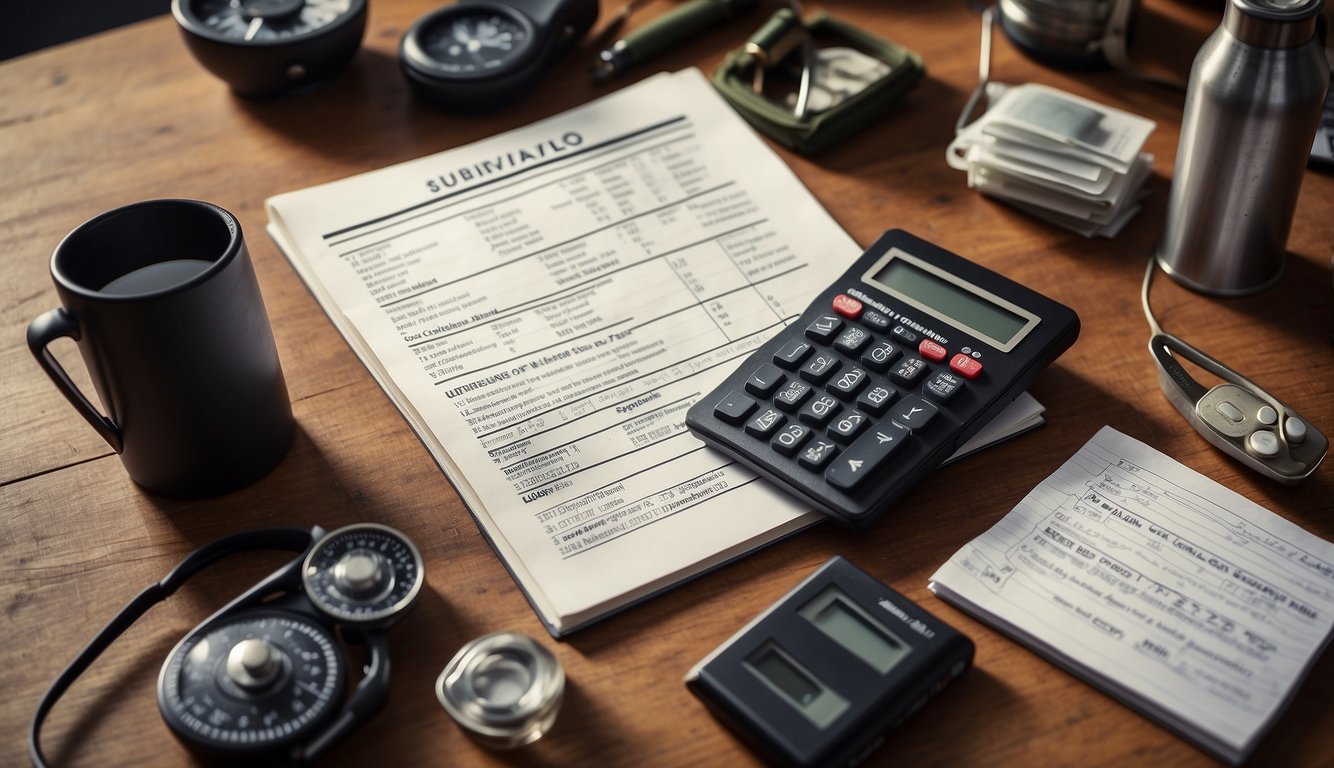
In a situation where every resource counts, you need a strategic approach to purchasing survival gear and supplies. Ensuring you have the essentials without breaking the bank is key.
Prioritizing Investments
Begin by assessing your most critical needs: shelter, water, and food. Shelter keeps you protected from the elements, so allocate funds towards a reliable tent or materials for fortification. Next, water filtration systems are vital as you may not always have a clean water source; prioritize these in your budget. For food storage, invest in non-perishable items like rice, beans, and canned goods that have a long shelf life.
- Shelter: Tent or building materials
- Water: Filtration system, storage containers
- Food Storage: Non-perishables with high caloric value
Beyond the basics, consider a generator for power outages but compare fuel types and efficiency to fit your budget. Lastly, a comprehensive first aid kit is indispensable; ensure it includes supplies to handle common injuries and illnesses.
Cost-Effective Resource Gathering
To accumulate supplies without overspending:
- Look for discounts and buy in bulk when possible, especially for non-perishable food items.
- Research and compare prices on durable and multifunctional gear to get the most value.
- Consider alternatives to expensive items; for instance, bleach can be used for water purification as a budget-friendly option.
- Explore do-it-yourself options where feasible, such as creating your own first aid kit with essential items.
By following these strategies for budgeting and resource gathering, you’ll be better prepared without unnecessary financial strain.
Shelter and Home Preparations
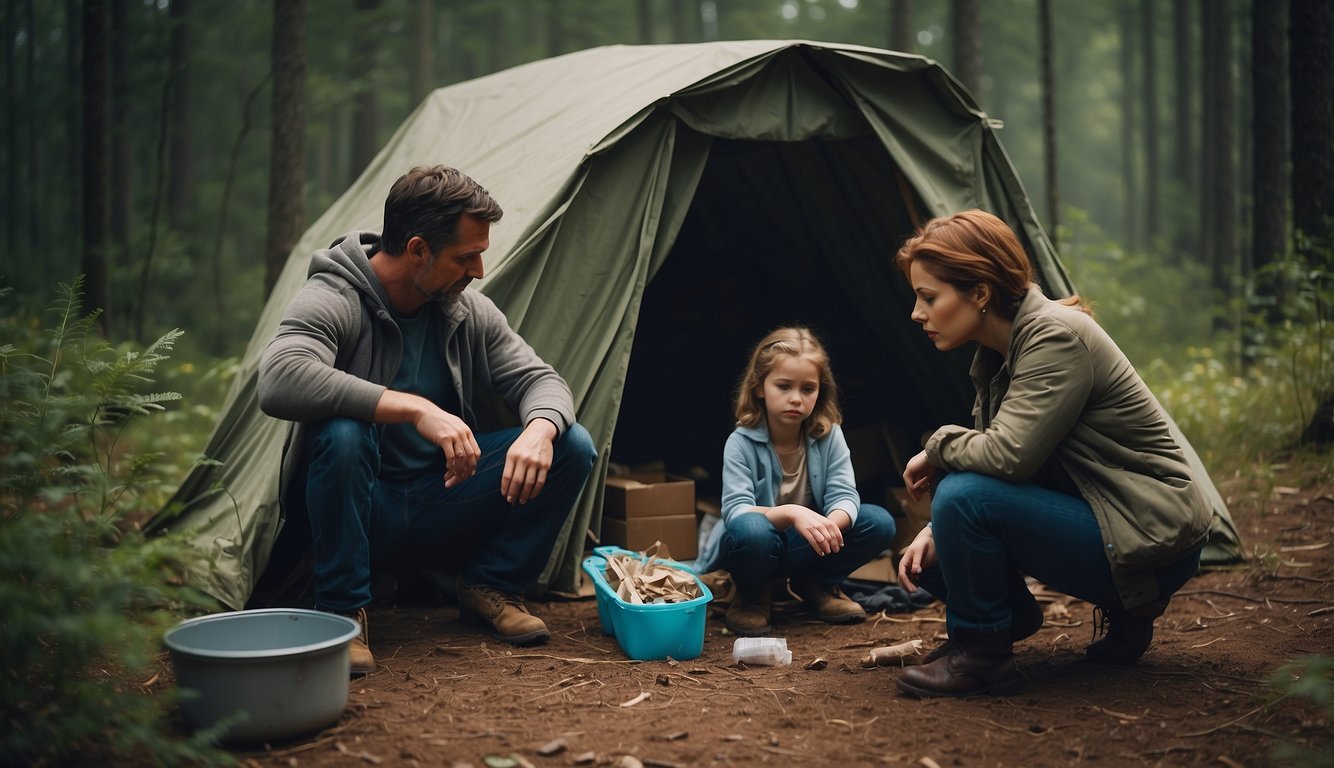
In a SHTF scenario, ensuring you have a secure and well-prepared shelter can make a significant difference. Careful consideration is needed to choose and fortify your shelter, decide whether to bug in or out, and manage your home stockpile effectively.
Choosing and Fortifying a Shelter
Your primary shelter should be structurally sound, protected from the elements, and hidden from plain sight. Whether it’s your home, a bunker, or a remote cabin, reinforce entry points with sturdy locks and security measures. Consider the use of sandbags or barricades for additional protection against potential threats.
- Primary Shelter: Home/Bunker/Cabin
- Reinforce doors/windows
- Install quality locks/security
- Utilize barricades where necessary
Bugging In vs. Bugging Out
Bug in when your home can provide the safety and resources needed to survive. It should offer a reliable water source, food stockpile, and be defendable. Bug out only if your current location is untenable or compromised.
Bug In: If Home is Safe
- Ensure water source is secure
- Food stockpile accessible
- Home is defensible
Bug Out: If Home is Compromised
- Prep bug-out bag with essentials
- Scout for alternative shelters: Tent/Bunker
- Plan multiple evacuation routes
Home Stockpile Management
Create an inventory of your resources, and keep your stockpile organized by rotating supplies and checking expiration dates. Store your items in a cool, dry place to extend their shelf life.
- Stockpile Inventory:
- Categorize items (Food, Water, Medical)
- Rotate and check for expiration
- Maintain cool, dry storage conditions
By considering these critical aspects, you’ll dramatically improve your chances of maintaining safety and sustenance during uncertain times.
Resource Management and Sustainability
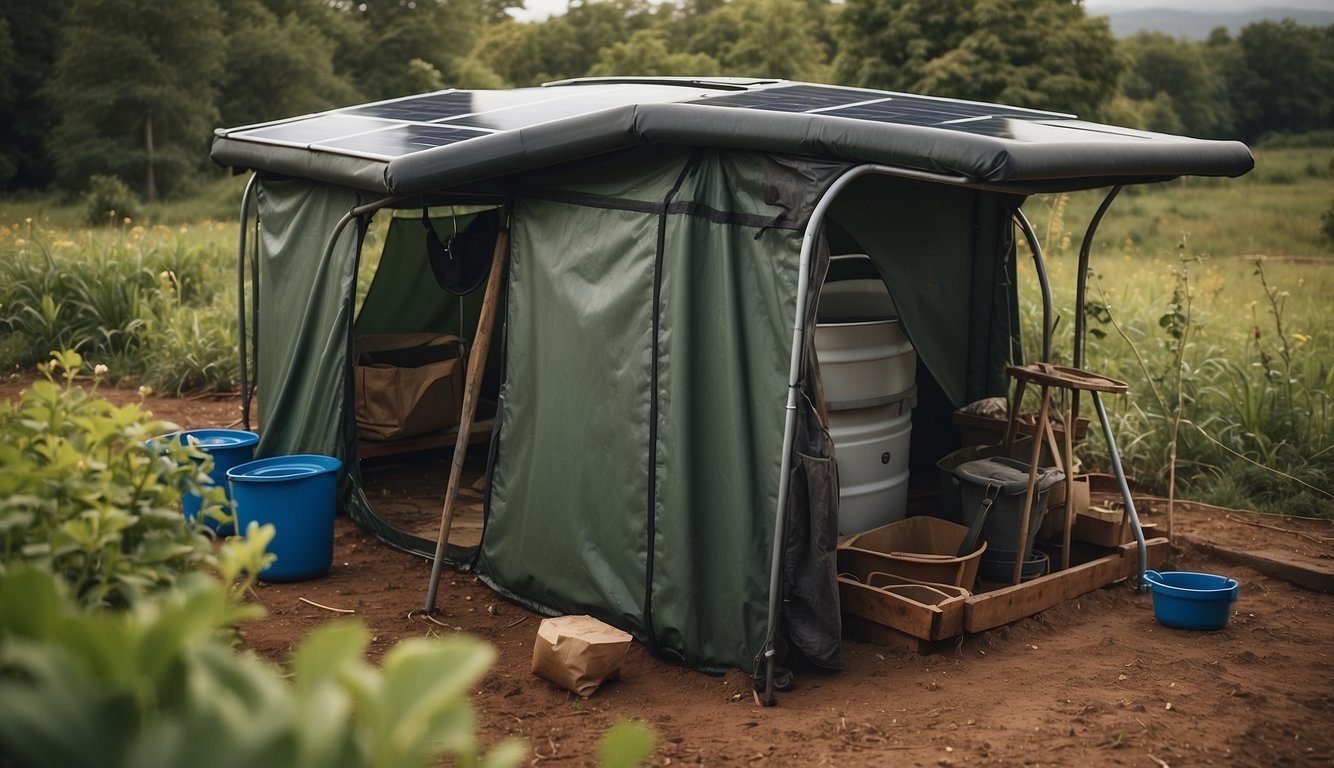
In a SHTF scenario, effectively managing your resources is crucial for survival. Your focus must be on establishing secure and sustainable supplies of essential resources; namely food and water, as well as ensuring you have reliable energy solutions.
Food and Water Security
Your top priority should be to secure a stable supply of food and water. For food, consider the following:
- Non-perishable items: Stock up on canned goods and dried foods that have a long shelf-life.
- Growing your own: If space allows, a garden can provide fresh produce. Start with easy-to-grow vegetables and calorie-rich crops like potatoes.
- Preservation methods: Learn techniques such as drying, smoking, and canning to preserve your harvests.
For water security, keep these points in mind:
- Storage: Store enough water for at least three days. The recommended amount is one gallon per person per day.
- Purification: Have the means to purify water, such as boiling, using purification tablets, or a filtration system.
- Renewable sources: Identify and test local water sources such as streams or wells.
Energy and Power Solutions
Power grid failure is a common concern in SHTF scenarios. To address electricity needs:
- Alternative energy sources: Invest in solar panels or wind turbines to harness natural energy.
- Fuel Storage: Keep a reserve of fuel for generators but use this sparingly as it is a finite resource.
- Efficiency: Reduce energy consumption by focusing on essential needs, using LED lighting, and insulating your shelter to maintain temperature.
Remember, your survival depends on how effectively you can procure, preserve, and manage the resources you have at your disposal.
Health, Sanitation, and Well-being
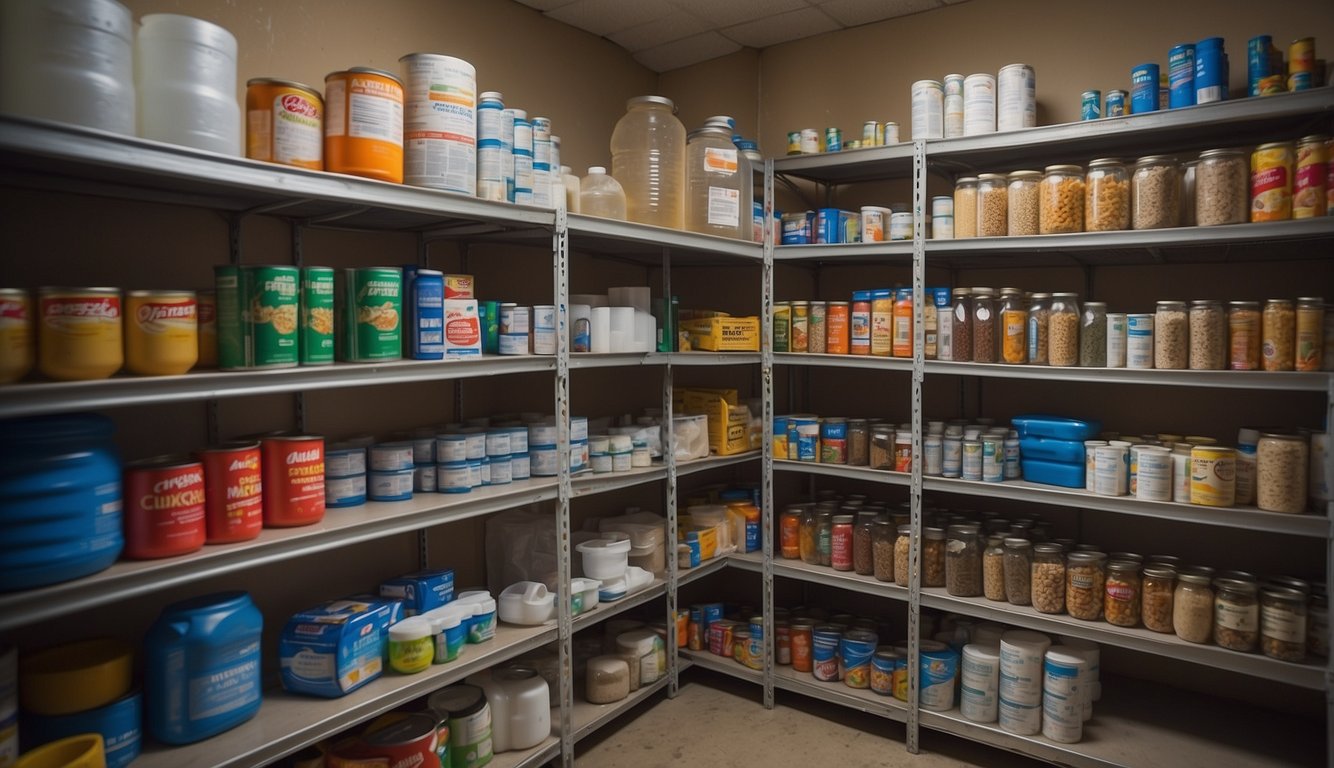
In a SHTF situation, prioritizing health, sanitation, and mental well-being is vital for survival. Your planning must ensure you have the essentials to combat illness and maintain hygiene, alongside safeguarding your mental health under stress.
Medical Supplies and First Aid
You must stock a comprehensive first aid kit that caters to a range of medical situations:
- Basic supplies: Adhesive bandages, gauze, medical tape.
- Instruments: Tweezers, scissors, thermometers.
- Medications: Pain relievers, antihistamines, antiseptics.
Offset medical supply costs by purchasing generics and consider basic first aid training to effectively address common injuries.
Maintaining Hygiene During Disasters
Effective sanitation practices dramatically reduce the spread of disease. Build your hygiene kit with these essentials:
- Water purification: Tablets, filters, boiling techniques.
- Sanitary products: Soap, alcohol-based hand sanitizers, toothpaste.
Depend on regular handwashing and safe waste disposal practices to eliminate pathogens and maintain a clean environment.
Mental Health Considerations
Mental well-being is just as crucial as physical health. Allocate resources to:
- Stress relievers: Books, games, stress balls.
- Comfort items: Personal mementos, photographs.
Maintain a routine and create a sense of normalcy, which can help in managing anxiety and preserving mental health during a crisis.
Security and Personal Safety

In a SHTF situation, securing your personal safety is paramount. Anticipate potential threats and understand how to protect yourself from violence. Preparedness in self-defense and a strategic approach to confrontations is essential for survival.
Self-Defense and Protection
Self-defense: It’s crucial to equip yourself with both the knowledge and the tools for self-defense. In terms of ammunition, ensure that you have a sufficient supply, but remember to adhere strictly to laws and order to avoid legal consequences.
- Non-lethal options: Consider possessing pepper spray, tasers, or even a gas mask for protection against chemical threats.
- Physical training: Engage in regular physical fitness and self-defense training to enhance your ability to fend off an attacker.
Dealing with Threats and Violence
Strategic response:
When faced with threats, assess the situation carefully before responding. Your reaction should aim to de-escalate violence whenever possible.
- Avoid confrontations: Whenever it is safe and possible, avoid areas known for violence or unrest.
- Home security:
- Reinforce doors and windows to secure your premises.
- Install discreet security measures like motion sensor lights.
- Legal considerations: Stay informed on self-defense laws in your area to ensure any measures you take are within legal boundaries.
Communication Strategies

In a SHTF scenario, your ability to communicate efficiently can be a critical factor in your survival. You need reliable methods to stay informed and maintain contact with others, despite the potential failure of conventional communication systems.
Staying Informed
Listen-Only Devices: Equip yourself with battery-operated or hand-crank radios to receive news and emergency broadcasts.
- NOAA Weather Radio: A must-have to get alerts from the National Weather Service.
- AM/FM Radio: For local news and updates.
- Monitoring Community Channels: Tuning into HAM radio frequencies can offer real-time information from amateur radio operators in the community.
Establishing Contact with the Outside World
- Cell Phones: In the initial stages of a crisis, cell phones may work but expect network congestions or outages.
| Cell Phone Function | Reliability |
|---|---|
| Calls | Low |
| Text Messages | Medium |
- HAM Radio: Obtain a HAM radio license pre-crisis and secure a radio to communicate over long distances.
- Handheld Walkie-Talkies: Useful for short-range communication within your local group, essential when cellular networks are down.
- Satellite Phones: Considered for remote areas, where traditional signals are unreachable. High cost but can be vital for reaching out for help or connecting with family.
Survival Networking and Community Building
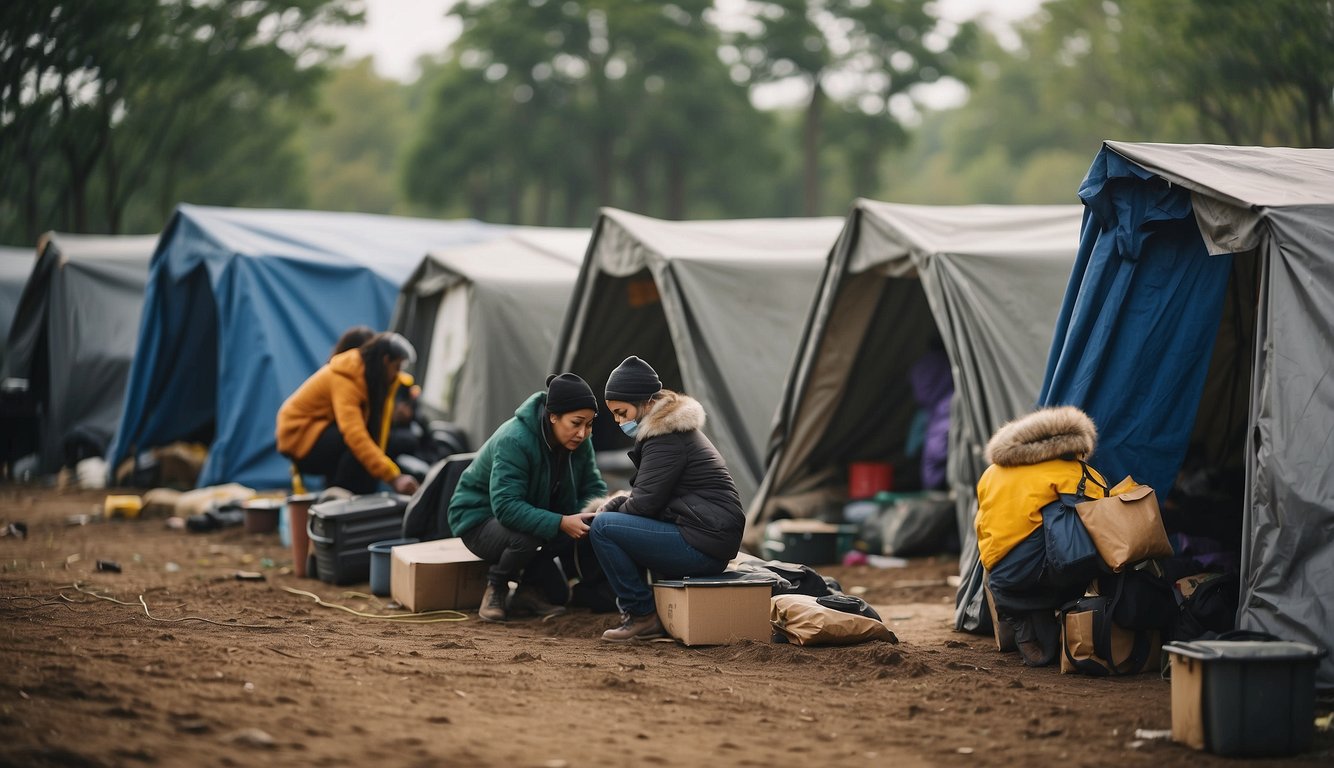
In a SHTF situation, your ability to survive could hinge on the community and networks you’ve built. Here’s how to leverage those connections for mutual aid and support.
The Role of Community in SHTF Survival
In the midst of chaos, your survival often depends on the collective strength and resources of a community. By joining forces with others, you can combine skills and supplies, which is crucial when every resource counts. Consider the following:
- Skill Diversity: Every person brings a unique set of skills that can prove vital during emergencies. You should identify and connect with individuals having skills like medical knowledge, mechanical repair, or food preservation.
- Resource Sharing: Pooling resources ensures that essential supplies such as food, water, and medication are distributed according to the needs of the community, thus enhancing collective survival chances.
Building and Sustaining Mutual Aid Networks
Creating a network of like-minded individuals focused on mutual aid can strengthen your preparedness for a SHTF scenario. To establish an effective network:
- Identify Potential Members: Scout for individuals who are reliable and share a common goal of preparedness. This can be through local community groups, online forums, or prepper meetups.
Define Roles and Responsibilities: Clearly establish who is responsible for what. This clarity helps in coordinating efforts seamlessly during an emergency.
- Medical: Individuals with medical training
- Logistics: Members skilled in organizing supplies and aid
- Security: People trained to ensure the safety of the community
- Regular Meetings and Drills: Schedule regular gatherings to plan, allocate resources, and conduct drills. This practice helps in reinforcing the network and keeping everyone aligned with the shared goals.
By focusing on these areas, you can create a framework for a robust survival network capable of weathering the storms that come with SHTF events. Remember that in trying times, your greatest asset is the community you’ve nurtured and the networks you’ve established.
Practice and Preparedness Drills
When facing a situation where resources are scarce, you need to be well-practiced in survival skills. Drills are not just for physical readiness; they also enhance your mental preparedness and situational awareness.
Regular Drills: Implement a regular schedule to practice your emergency plans. It might include monthly fire-making sessions or quarterly evacuation drills. Maintaining a rhythm ensures your skills remain sharp and reactions become second nature.
Scenario Practice: Tailor practice sessions to various scenarios, ranging from power outages to natural disasters. This variety prepares you for the unpredictable nature of a SHTF situation.
- Fire Drills: Ensure everyone knows how to start a fire safely.
- Shelter Building: Practice erecting temporary shelters efficiently.
- Mock Evacuations: Time how quickly you can leave and note improvement areas.
Skill Stations: Set up stations to focus on specific skills such as water purification, first aid, or tool repair. Rotate through these to maintain a broad skillset.
Situational Awareness: Always include exercises that enhance your ability to recognize and adapt to changing conditions. This could be as simple as a hike with unexpected “emergencies” along the route.
In conclusion, your survival relies on your ability to execute your skills under pressure. Discipline yourself with practice and regular preparedness drills so that if a SHTF situation occurs, your resource management is effective and second nature.
Dealing with Specific Types of Disasters
When disaster strikes, your response hinges on the type of emergency. Below, you’ll find strategic guidance for handling two prominent categories: natural events and human-caused crises.
Natural Disasters
Hurricanes and Flooding:
- Preparation: Secure your home with storm shutters, sandbags, and waterproofing measures.
- Financial Tip: Set aside an emergency fund specifically for post-storm repairs and necessities.
Wildfires:
- Preparation: Create a defensible space by clearing flammable materials around your property.
- Expenditures: Invest in fire-resistant materials for your home and proper insurance coverage.
Tornadoes:
- Readiness: Designate a storm shelter and practice emergency drills.
- Funds Management: Ensure access to emergency cash as banking services may be interrupted.
Man-Made Catastrophes
EMP Attack:
- Preparation: Shield electronics and maintain a non-electric backup for essential appliances.
- Survival Budgeting: Prioritize resources that will be functional without power, such as manual tools.
Biological Warfare:
- Readiness: Stockpile protective gear such as masks and gloves, and keep vaccinations up to date.
- Emergency Funds: Allocate budget for medical supplies and long-term sustainment if services are disrupted.
SHTF Budgeting Tips and Tricks
When facing a SHTF scenario, budgeting your limited resources becomes crucial. Your preparation involves meticulous planning and smart economic choices to ensure long-term survival within your means. Here’s how you can make the most of your finances during uncertain times.
Analyze Your Expenses: Start by categorically listing your current expenses. Review this list and identify non-essential spendings. In a SHTF situation, avoiding luxury items at the grocery store and focusing on necessities can stretch your dollar further.
Invest in Long Shelf-Life Items: Stock up on goods with extended shelf life, prioritizing affordable items like rice, beans, and canned goods. These staples can be bought in bulk, providing variety and nutrition without frequent replenishing.
Economize by Buying in Bulk: Purchase non-perishable goods in bulk to take advantage of lower prices. Always compare unit costs to ensure you’re getting the best deal for the quantity.
Examples:
| Item | Unit Price | Bulk Price |
|---|---|---|
| Rice, 1 lb | $1.00 | $0.75 |
| Beans, 1 lb | $1.50 | $1.00 |
| Canned Vegetables, 1 can | $0.80 | $0.50 |
Practice Self-Sufficiency: Learn skills such as gardening or water purification. Not only do these skills save money in the long term, but they also ensure a degree of independence from market fluctuations.
Remember, the key to successful SHTF budgeting is to conserve funds, prioritize essential items with a longer shelf life, and cultivate a versatile set of skills to minimize dependency on the economy. By mapping out your plan and reviewing it regularly, you ensure you are always prepared, regardless of what the future holds.
Ethical Considerations
During a crisis, remaining within legal boundaries and upholding ethical standards are crucial, not only for societal order but also for your safety and the well-being of others around you.
Navigating Law Enforcement Interactions
Interactions with law enforcement officials can be stressful, yet understanding your legal rights is critical. You have the right to:
- Remain silent: To avoid self-incrimination, you may exercise this right, informing officers you choose not to speak until legal counsel is present.
- Decline searches: Without a warrant or probable cause, you can legally refuse to consent to a search of your person or property.
Recall the response during Hurricane Katrina, where law enforcement was overwhelmed, leading to both protection and coordination challenges. Your compliance with directives should be balanced with a knowledge of your legal protections to ensure fair treatment.
Ethics of Survival and Resource Allocation
Resource allocation in survival scenarios hinges on ethical principles where decisions may impact the well-being of yourself and others. Consider the following:
- First-come, first-served: Though instinctual, this may not be the ethical approach if it leads to an imbalanced distribution of resources critical for survival.
- Need-based allocation: Prioritize resources for the most vulnerable, such as the elderly, children, or medical facilities.
Ethical decision-making in a SHTF situation often involves difficult choices that test your morals against the instinct for self-preservation. Remember, during events like Katrina, ethical considerations around resource distribution had life-and-death implications. Your decisions should aim to reflect a balance between individual needs and the greater good.
Conclusion: Staying Vigilant and Adaptable
In the realm of survival, your capacity to stay vigilant and adaptable can make the difference between thriving and merely surviving. Vigilance ensures that you are always aware of your surroundings and the state of your resources. Regularly inspect your water supplies, check for leaks or contamination, and stay informed about potential changes in your environment that may necessitate a shift in your strategy.
Adaptability means having the foresight to plan for various scenarios while being ready to adjust those plans as needed. Remember that the conditions post-SHTF can change rapidly, and your ability to pivot is crucial. Stay flexible in your thinking, willing to adopt new methods for managing resources, and open to learning from every experience.
Your Checklist for Vigilance:
- Monitor your resource levels consistently.
- Stay informed about environmental changes.
- Inspect storage areas for integrity and security.
Your Guidelines for Adaptability:
- Develop multiple contingency plans.
- Learn new survival skills systematically.
- Be willing to change plans when necessary.
Whether you’re dealing with a budget constraint or confronting a full-blown crisis, approaching each situation with a confident mindset, grounded in knowledge and balanced by neutral judgement, will serve you well. Equip yourself with the tools and skills to manage your resources, and cultivate a mindset that embraces change and challenge. Remember, survival is not just about endurance; it’s about responding intelligently to the unexpected.

Leave a Reply